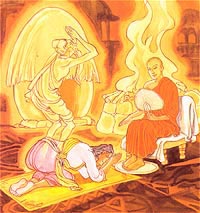19X12 Friday LESSON 727 திபிதக மூன்று கூடைகள் ![]() TIPITAKA from FREE ONLINE eNālāndā Research and Practice UNIVERSITY through http://sarvajan.ambedkar.org-Dhammapada Verse 392 Sariputtatthera
TIPITAKA from FREE ONLINE eNālāndā Research and Practice UNIVERSITY through http://sarvajan.ambedkar.org-Dhammapada Verse 392 Sariputtatthera
Vatthu-Honour To Whom Honour Is Due
Verse 392. Honour To Whom Honour Is Due
From whom one knows the Dhamma
by Perfect Buddha taught
devoutly one should honour them
as brahmin sacred fire.
Explanation: If a seeker after truth were to learn the Word
of the Enlightened One from a teacher, that pupil must pay the Teacher
due respect, like a brahmin paying homage assiduously and with respect
to the sacrificial fire.
Dhammapada Verse 392
Sariputtatthera
Vatthu
Yamha dhammam vijaneyya
sammasambuddhadesitam
sakkaccam tam namasseyya
aggihuttamva brahmano.
Verse 392: If from somebody one should learn
the Teaching of the Buddha, he should respectfully pay homage to that teacher,
as a brahmin worships the sacrificial fire.
The Story of Thera Sariputta
While residing at the Jetavana
monastery, the Buddha uttered Verse (392) of this book, with reference to the
Venerable Sariputta.
The Venerable Sariputta was born
of brahmin parents of Upatissa village; that was why he was named Upatissa. His
mother was Sari. His very close friend was Kolita, another brahmin youth, son of
Moggali. Both the youths were searching for the right doctrine, which would lead
them to liberation from the round of rebirths, and both of them had a great
desire to enter a religious Order. First, they went to Sancaya, but they were
not satisfied with his teaching. Then they wandered all over Jambudipa looking
for a teacher who would show them the way to the Deathless, but their search was
fruitless. After some time, they parted company but with the understanding that
the one who found the true dhamma first should inform the other.
About that time, the Buddha
arrived at Rajagaha with a company of bhikkhus, including Thera Assaji, one of
the group of the first Five Bhikkhus (Pancavaggis). While Thera Assaji was on an
alms-round, Upatissa saw the thera and was very much impressed by his noble
countenance. So Upatissa respectfully approached the thera and asked who his
teacher was, what doctrine his teacher taught, and also briefly to explain the
doctrine to him. Thera Assaji then told Upatissa about the arising of the Buddha
and about his sojourn at the Veluvana monastery in Rajagaha. The thera also
quoted a short stanza connected with the Four Noble Truths.
The verse runs thus:
Ye dhamma hetuppa bhava
tesam hetum tathagato aha
tesanca yo nirodho
evam vadi maha samano.
It means:
The Tathagata has declared the
cause and also the cessation of all phenomena which arise from a cause. This
is the doctrine held by the Great Samana.
When the verse was only half-way
through, Upatissa attained Sotapatti Fruition.
As promised, Upatissa went to his
friend Kolita to inform him that he had found the true dhamma. Then the two
friends, accompanied by two hundred and fifty followers, went to the Buddha who
was then at Rajagaha. When they arrived at the Veluvana monastery, they asked
permission to enter the Buddhist Order, and both Upatissa and Kolita, together
with their two hundred and fifty followers, were admitted as bhikkhus. Upatissa,
son of Sari, and Kolita, son of Moggali, then came to be known as Sariputta and
Moggallana. Soon after their admission to the Order, the Buddha expounded to
them a dhamma and the two hundred and fifty bhikkhus attained arahatship; but
Moggallana and Sariputta attained arahatship only at the end of seven days and
fifteen days respectively. The reason for the delay in their attainment of
arahatship was that they had made a wish for Chief Discipleship, which required
much more striving to achieve perfection.
The Venerable Sariputta always
remembered that he had been able to meet the Buddha and attain the Deathless
through the Venerable Assaji. So, he always paid obeisance in the direction
where his teacher was and he always went to bed with his head lying in the same
direction. Other bhikkhus who were staying with him at the Jetavana monastery
misinterpreted his actions and said to the Buddha, “Venerable Sir! The
Venerable Sariputta still worships the various directions, viz., the East, the
South, the West, the North, the Nadir and the Zenith, as he has done before as a
brahmin youth; it seems as if he has not yet given up his old beliefs.” The
Buddha sent for the Venerable Sariputta and Sariputta explained to the Buddha
that he was only paying obeisance to his teacher, the Venerable Assaji, and that
he was not worshipping the various directions. The Buddha was satisfied with the
explanation given by the Venerable Sariputta and said to the other bhikkhus,
“Bhikkhus! The Venerable Sariputta was not worshipping the various
directions; he was only paying obeisance to his teacher and benefactor, through
whom he had attained the Deathless. It is quite right and proper for him to pay
homage to such a teacher.”
Then the Buddha spoke in verse as
follows:
| Verse 392: If from somebody one should learn the Teaching of the Buddha, he should respectfully pay homage to that teacher, as a brahmin worships the sacrificial fire. |